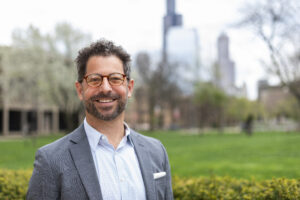The success of the residential program at 851 N. Leamington St. increases each year, said Rochelle Sims, a certified alcohol and drug counselor and co-director of SisterHouse. Every year, a higher percentage of women achieve sobriety, Sims said.
SisterHouse was founded by Sister Anne Meyers as a safe haven for women coming out of prison.
Since 1992, 99 percent of the primarily homeless, middle-aged, African-American women who become SisterHouse residents come to the facility directly from detox programs rather than the streets, Sims said.
“We won’t allow you to become a resident here unless you’ve been clean and sober for at least a month,” said Sims.
SisterHouse is one of more than 20 substance abuse treatment centers in Chicago, but is one of just four residential centers for women only.
Like many not-for-profit centers, SisterHouse’s proceeds come largely from donations and grants, which in 2006 made up 83 percent of the program’s income.
Fundraising activities and program fees-which residents are not required to pay until after they have gone through the program and are gainfully employed-also play a part, accounting for 17 percent of last year’s earnings.
The center’s expenses include program and general administration costs as well as money spent on fundraising activities.
“Last year was a good year for SisterHouse, and this year has been great,” said Sister Shannon Scallon, co-director of SisterHouse.
In 2006, 73 percent of the 19 women who completed the program at SisterHouse left with full-time employment, including benefits.
“How much would the White Sox pay for a batter who could bat 73 percent? A gazillion dollars! That number is outstanding!” said Scallon.
And in May 2007, 11 women completed the 18-month program, which was more than graduated in 2005 and 2004, said SisterHouse alumni Eunice Miller, a 2004 graduate who volunteers at the center.
The reason more and more women succeed every year has little to do with the structure of the program, which has remained the same since 1992. Instead, the program’s success is attributed to the willingness of the women to change their lives, said Sims.
“It seems more and more drug-addicted women are willing to surrender; they know they can’t change on their own,” said Miller, who said her decade-long heroin addiction was the result of childhood molestation by her father.
SisterHouse’s three-phase program is extremely effective in forcing women to first realize and then face the root of their drug addiction, Miller said.
“I was letting my dad win; but once God helped me forgive him, I was able to let go of my rage and heal,” Miller said.
Many of the women who come to SisterHouse were abandoned, molested or physically abused as children, said Miller.
Approximately 80 percent of women nationwide who sought substance abuse treatment in the past three years reported lifetime histories of sexual or physical assault, according to a recent National Institute on Drug Abuse (NIDA) study.
“We use drugs to suppress our pain from the past; they’re a crutch,” said 46-year-old Amelia Stevens, a current resident at SisterHouse.
Stevens, who grew up in Chicago’s Lincoln Park neighborhood, began abusing alcohol and crack-cocaine in 1990. Although she was able to stop using in 1995, she started again heavily nine years later.
“I was a spoiled child, a brat; I was the youngest in my family,” Stevens said. “And when my mom passed away, I couldn’t deal with anything anymore. That’s when I started using.”
Stevens, who has been at SisterHouse since August, said phases one and two of the program, which last three months each, are designed to help residents realize the source of their substance abuse.
During these two phases, women develop self-awareness, personal spirituality and accountability to the rules of the home.
Residents also spend this time studying the first five steps of the Alcoholics Anonymous (AA) 12-step program and undergo 15 hours of intensive outpatient therapy per week, said Sister Scallon.
The third phase of the program lasts three to 12 months, during which the women develop a network of supportive relationships for lifelong sobriety, said Sims.
Finding a stable job, making future living arrangements and learning time and money management are also part of phase three.
Once a woman has completed all three phases, she must spend a minimum of one year living away from SisterHouse-maintaining sobriety-before she can come back to graduate, Sims said. This ensures that she is able to continue her recovery process beyond the strict regiment of the program.
Are residential treatment programs vital to the recovery of drug-addicted women? A 2006 study suggests so.
The study, conducted by the University of Iowa and the University of California’s Institute for Health and Aging, found that women who completed therapeutic programs followed by short-term residential treatment- one-to-three-year programs -were more likely to abstain from drugs (65 percent) than women who did not undergo residential treatment (30 percent).
Women who completed the residential treatment were also more successful at forging social support systems in their communities after leaving treatment, according tohttp://www.substanceabusepolicy.com/Substance Abuse Treatment, Prevention and Policy, an online medical journal.
For 29-year-old Jessica Vaughan, who has been at SisterHouse for six months, healing has meant humbling herself.
“SisterHouse has showed me I have character defects, one of them being that I always think I know what’s best; but I really don’t,” said Vaughan, who said she never got counseling as a child after being violently beaten by her step-dad on many occasions.
The physical and sexual abuse she endured when she was young is what led to her 11-year abuse of “any and every drug” she could get her hands on, Vaughan said.
“Sometimes I feel stuck at SisterHouse, I feel like I should be doing something better,” said the Wisconsin native. “But then I remind myself that if I weren’t living here, I’d be living on the streets.”
Categories:
Mind & Body Public
Tags:
school sisters of notre dame sisterhouse substance abuse






Be First to Comment